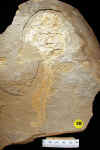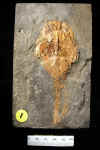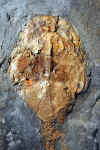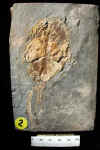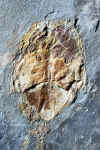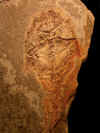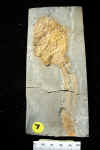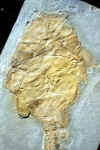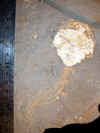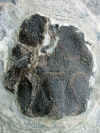PLACODERMI Arthrodires
The name is derived from Greek -Placo (plate) – derm(skin). Although some of the first Palaeozoic fish to be described (by Miller and then Agassiz) their origins were widely disputed. They were considered to be variously invertebrates, turtles or jawless fish. Their characteristic feature is a bony headshield connected to a thoracic shield covering the anterior part of the body. In primitive forms the head-thoracic armor junction is not articulated, but some form of articulation (always found on the dorsolateral plate) has developed in most higher forms. They are mostly dorsoventrally compressed and posterior to the trunk plates the body is variously, covered with large scales (Pterichthyodes), small scales (Lunaspis) or is naked (Coccosteus)
The oldest known placoderms come from the
early Silurian of China, but they dominated the Devonian period ,disappearing in
the late Devonian (Famennian) when they seemed to have undergone a sudden mass
extinction.
There are 6 -8 major orders of Placoderm (depending on the latest literature) with about 200 known genera. Ptyctodontids, rhenanids and acanthothoracids are considered primitive, antiarchs and arthrodires the most advanced, with the petalichthyds as an intermediate form. Beyond that, the phylogeny seems to be very complex and hotly debated.
Arthrodires
The arthrodires (jointed neck) were by far the most abundant (60 pct of all known species) and diverse of the placoderms. The 3 major groups are the Actinolepidoidei (including phyllolepids), the Phlyctaenii and the Brachythoraci. They are characterised by having two pairs of upper jaw tooth plates called superognathals. Arthrodires include the massive Late Devonian forms found in the Cleveland shale of the US and Sahara of Morocco – Dunkleosteus (6-7 M in length) a predatory dinichthyid (‘terrible fish’) and Titanichthys a 7M long filter feeder (postulated habit because of smaller blunt jaws).
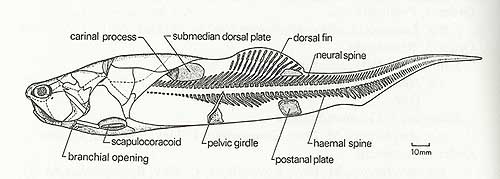
Coccosteus cuspidatus - a classic Mid-Devonian Brachythoracid in lateral view
Arthrodires in my collection (click on thumbnails to see larger images)
Coccosteus cuspidatus MORS
Found in the mainly in the Achanarras Horizon and probably extending into the Spittal Beds of he MORS, this Brachythoracid Arthrodire had powerful jaws equipped with both shearing surfaces and serrated 'tooth-like' structures.

 Mid Devonian Achanarras
quarry,
Scotland
Mid Devonian Achanarras
quarry,
Scotland
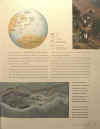 Above featured in British Isles A Natural History (A Titchmarsh)
Above featured in British Isles A Natural History (A Titchmarsh)
 Coccosteus cuspidatus
(acid prep)
Coccosteus cuspidatus
(acid prep)
Millerosteus minor Mid Devonian Caithness, Scotland
Millerosteus is another Coccosteid which is found in the Upper Mey Beds of Caithness and the Rousay Flags of Orkney. At about 12 cm it was around a third of the size of Coccosteus c.. As can be seen from the specimens below, the ornamentation consists of rows of Tubercules. Often found in plates containing several fish it has been suggested they hunted in shoals.
Dickosteus threiplandi Mid Devonian Caithness, Scotland
Watsonosteus fletti Mid Devonian, Orkney, Scotland
Phyllolepid arthrodires from Australia
Flattened and heavily armored forms, the name is derived from the words 'leaf scale', referring to the single large nuchal plate covering two thirds of the head and body, and which is ornamented with a pattern of concentric ridges. They are thought to have been predatory, lying flattened on the bottom of a lake, waiting to ambush passing fish swimming above. For some time there was a school of thought that they were not arthrodires because of the reported absence of the posterior lateral and dorsolateral plates as well as having no cranio-thoracic articulation. In fact, Ritchie recently demonstrated that Cowralepis possess very reduced but hidden remnants of the posterior dorsolateral plates. They also have two pairs of supergnathal toothplates and both anterior and posterior median ventral plates. Furthmore, it has now been shown that phyllolepids have a simple but well developed sliding joint in the craniothoracic articulation – Phyllolepids are highly derived arthrodires!
Cowralepis mclachlani, Late Middle Devonian, Cowra, NSW, Australia
Arthrodires from Morocco
Superb skull from Unknown Brachythoracid Brachythoracid Giventian Maider Late Devonian Spinal Plate from Dickonosteus-like arthrodire arthrodire jaws
Arthrodires from rest of world
Bryantolepis, Actinolepid, L. Devonian Beartooth formation, Wyoming Plourdosteus canadensis U. Devonian Escuminac Formation, Miguasha, Canada
 Unknown Jaw Devonian Silica
shale Ohio USA
Unknown Jaw Devonian Silica
shale Ohio USA
Arthrodires in Literature Catalogue of Fossil Fishes AS Woodward 1891 Coccosteus sp.
 How Coccosteus may have looked
How Coccosteus may have looked









